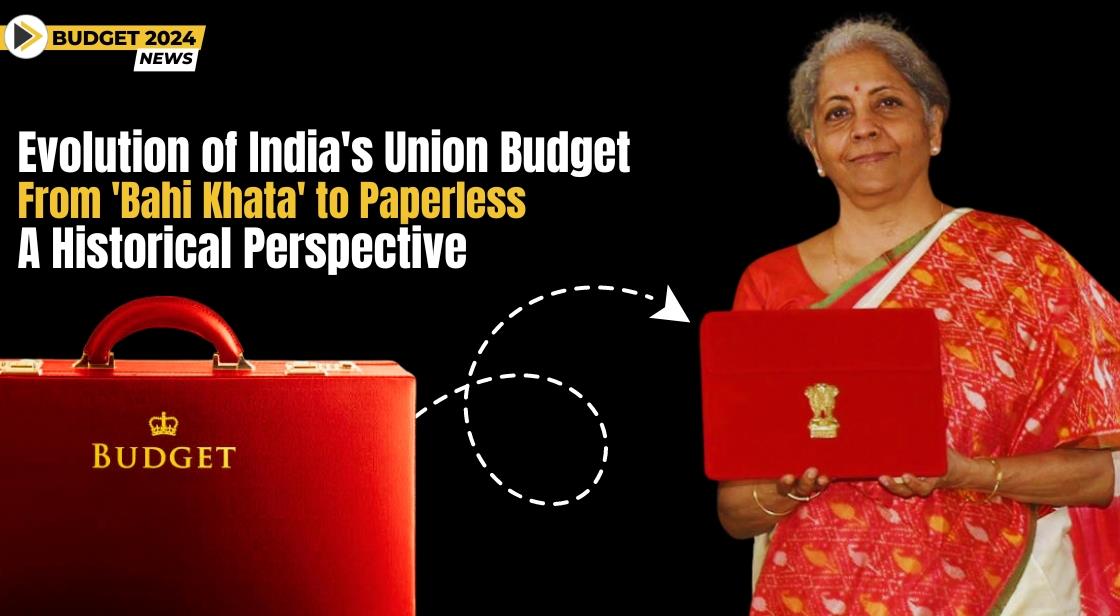Evolution of India's Union Budget: From 'Bahi Khata' to Paperless – A Historical Perspective

News Synopsis
As Union Finance Minister Nirmala Sitharaman gears up to present the interim budget on February 1, 2024, marking her sixth budget, it's imperative to reflect on the evolutionary journey of India's budgetary process since independence. From the first interim budget in 1860 to the technological advancements in recent years, the Union Budget has undergone a remarkable transformation.
1. India's First Interim Budget – 1860:
During the British era, James Wilson, a Scottish economist associated with the East India Company, presented India's maiden interim budget in 1860, laying the foundation for fiscal governance.
2. Post-Independence Initiatives – 1947:
Post-independence, RK Shanmukham Chetty presented India's inaugural interim budget in 1947, addressing critical issues such as food grain scarcity, import surges, and inflation.
3. Shifting Announcement Time – 2001:
Union Finance Minister Yashwant Sinha ushered in a change in 2001 by shifting the announcement time of the Budget from 5:00 pm to 11 am, breaking away from a colonial tradition.
4. Move to Bilingual Presentation – 1955-56:
A significant step in 1955-56 saw the budget printing process becoming bilingual, with budgets being presented in both English and Hindi, fostering inclusivity.
5. Leaked Budget – 1950:
In an unprecedented incident in 1950, the Union Budget was leaked during Finance Minister John Mathai's tenure, underscoring challenges in maintaining confidentiality.
6. Change in Budget Presentation Style – 2019:
In 2019, Finance Minister Nirmala Sitharaman introduced a visual shift, replacing the traditional briefcase with a 'bahi khata,' symbolizing a departure from conventional practices.
7. Technological Shift to Paperless – 2021:
A watershed moment in 2021 marked the transition towards a paperless budget, showcasing India's embrace of technological advancements in the budgetary process.
Longest budget speech India
8. Record-Breaking Budget Speech – 2020:
In 2020, Finance Minister Nirmala Sitharaman delivered the longest budget speech in India's history, lasting two hours and 42 minutes, although falling short of former Prime Minister Manmohan Singh's word count record.
India's budget presentation is a much-anticipated annual event, not just for its economic implications but also for the accompanying spectacle. And what adds to the drama is the length of the speech! Over the years, Finance Ministers have held the audience captive with marathon speeches, making some of them contenders for the title of "longest budget speech in India."
The Current Record Holder:
The current record for the longest budget speech in India belongs to Nirmala Sitharaman, the country's current Finance Minister. In her 2020 budget speech, she spoke for a staggering 2 hours and 42 minutes, surpassing all previous records.
Nirmala Sitharaman, Finance Minister of India
It's worth noting that while Sitharaman's speech holds the record for duration, the record for the most words in a budget speech belongs to Manmohan Singh, former Prime Minister and Finance Minister. In his 1991 budget speech, Singh used a whopping 18,650 words, outlining India's historic economic liberalization policies.
Other Notable Long budget Speeches:
- Jaswant Singh (2003-04): 135 minutes
- Arun Jaitley (2018-19): 1 hour and 49 minutes
- Nirmala Sitharaman (2019-20): 2 hours and 17 minutes
Why are Budget Speeches So Long?
The length of budget speeches can be attributed to several factors:
- The sheer volume of information: The budget covers a wide range of topics, from taxation and spending to economic policy and welfare schemes. Finance Ministers need to delve into each aspect in detail, leading to longer speeches.
- Political considerations: Budget speeches are often used to make political announcements and appeal to different sections of the population. This can result in additional talking points and extended speeches.
- Personal style: Some Finance Ministers simply prefer to take their time and deliver detailed explanations. This can be seen as a way to ensure clarity and transparency in the complex world of finance.
9. Budget Printing Location Change – After 1980:
Post-1980, the budget printing process was relocated from Rashtrapati Bhawan to Minto Road, signifying administrative changes for efficiency.
Records and Leaks: Interesting Sidelights
India's budget history is replete with fascinating trivia. In 2020, Nirmala Sitharaman delivered the longest budget speech ever - 2 hours and 42 minutes - although it fell short of former Prime Minister Manmohan Singh's record word count. 1950 saw a high-profile leak during Finance Minister John Mathai's tenure, prompting tighter security measures for future budgets. Additionally, the year 1955-56 marked the adoption of bilingual presentation, with budgets printed in both English and Hindi.
What is a digital budget?
A digital budget is a money management plan that uses electronic tools and apps to track income, expenses, and financial goals. Unlike traditional paper budgets, digital budgets offer a variety of benefits and features that can make managing your finances easier and more efficient.
Here are some of the key things to know about digital budgets:
- Accessibility: You can access your digital budget from anywhere with an internet connection, making it easy to stay on top of your finances on the go.
- Automation: Many budgeting apps allow you to automate tasks such as tracking income and expenses, categorize transactions, and generate reports. This can save you time and effort, and help you avoid errors.
- Visualization: Digital budgets often use charts, graphs, and other visual aids to represent your financial data. This can make it easier to see where your money is going and identify areas where you can cut back.
- Goal setting: Many budgeting apps allow you to set financial goals, such as saving for a down payment on a house or paying off debt. The app can then track your progress towards your goals and provide you with feedback.
- Security: Most reputable budgeting apps use encryption and other security measures to protect your financial data.
Conclusion:
The evolution of India's Union Budget is a testament to the dynamic nature of fiscal governance, blending tradition with innovation. From the colonial-era presentations to the contemporary digital age, each phase in the budget's evolution reflects the nation's commitment to adapt and enhance financial processes.
You May Like









